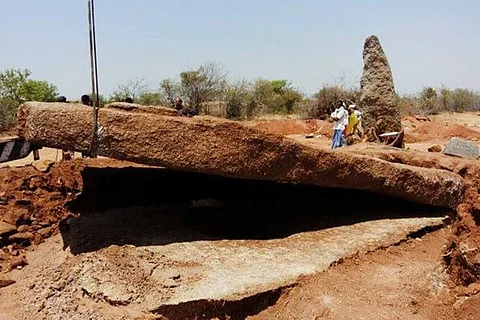

The Telangana Archaeology Department has excavated a stunning discovery – one of India's largest capstones, and the largest such stone in south India so far.
A capstone is a large, flat stone that usually serves as the roof of a megalithic tomb -- burial spots made out of large stones.
The massive capstone, which reportedly weighs about 40 tonnes was found at the excavation site in Narmeta village in Telangana's Siddipet district on March 21.
"It is indeed a moment of reckoning for the efforts of the Archaeology department, which is conducting large scale excavations at this site, resulting in this exciting discovery," the department said earlier in a statement.
Speaking to TNM, NR Visalatchy, the Director of Archaeology and Museums Department says, "The stone was around 6.7 metres long and two feet thick. It could be from around 500 BC or even a little older. A rough estimate would be around 2,750 years."
Megalithic structures have been known to span several pre-historic eras in history, with a structure like Stonehenge in England possibly being the most famous such structure.
The Archaeology department, which has set up camp at the Nangnaur mandal in Siddipet district for over 20 days now, and is conducting excavation works at a large burial site, came upon the latest discovery.
When asked how such a structure, carved out of a single block, could have been made, Visalatchy explains that a quarry very close to burial site could've provided the builders with the material.
"On the first day of the excavation, we explored the surrounding area and discovered that the humans living there used fire. Since it was after the Iron Age, they could've also used chisels to build it," she says.
She adds, "As far as moving it to the present spot is concerned, we enquired with some local elders in the villages nearby, and they narrated tales of how their ancestors used rolling wooden blocks to shift things. They could've even used animals."
Either way, Visalatchy adds that it must have been a massive task for the locals at the time, which suggests that the person who was buried beneath the capstone, was very important and held some significance in their society.
"This capstone is a prized one and a very unique find. We have never found anything on this scale before. We have parallely found small artifacts in other burial sites. We are optimistic that we may find something else too," she says.
All the findings from the site will reportedly go to the Centre for Cellular and Molecular Biology (CCMB) in Hyderabad for forensic testing, dating, and other experiments.
When asked about what the department plans to do with the stone, Visalatchy says, "We want to create a model of this burial in a museum. However, we'll need a lot of space, since the original burial is almost 10 metres long. Therefore, depending on the availability of space, we will go ahead."